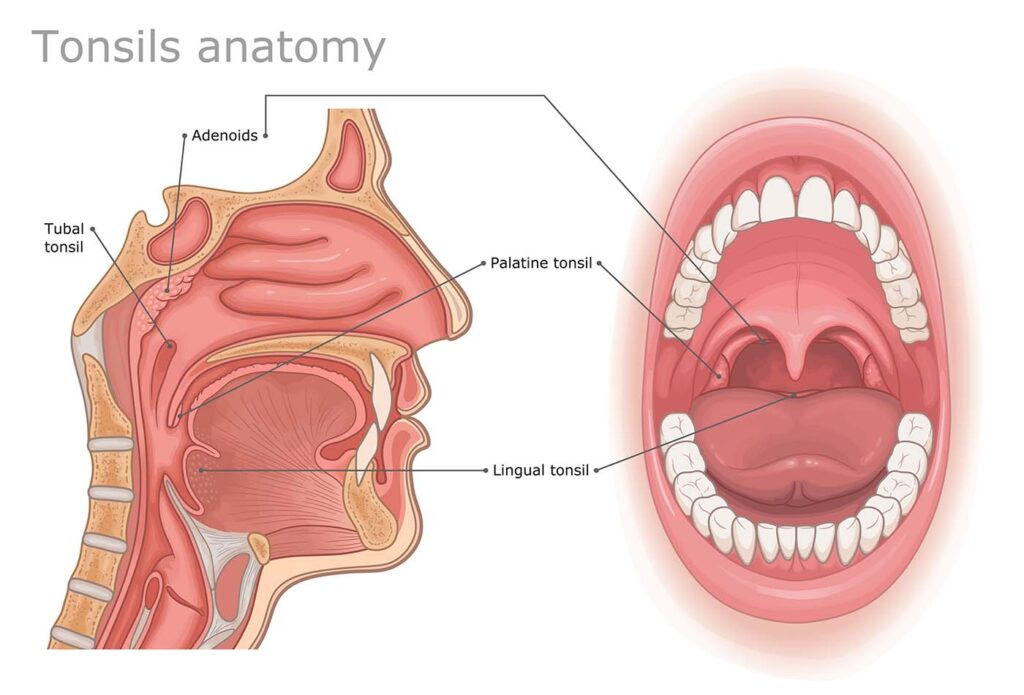As a parent, noticing your child’s persistent snoring, mouth breathing, or frequent sore throats and ear infections is concerning. These symptoms often signal enlarged tonsils or adenoids, which may disrupt your child’s sleep, health, and growth. While surgery is a common recommendation, it’s not always the only solution.
At The Orthospaceship – Hakim Orthodontics in Los Angeles, we empower parents with knowledge, offering enlarged adenoid treatment through a holistic, less invasive approach. In the right circumstances, our airway-focused orthodontic care can address these issues naturally, potentially avoiding surgery and fostering long-term wellness for your child.

What Are Tonsils and Adenoids?
Tonsils are two lymphoid tissues located in the back of the throat. Adenoids are a similar type of tissue but are located higher up, behind the nose and soft palate. Both are part of the immune system and help trap germs that enter through the mouth or nose. They are most active in early childhood and typically shrink during adolescence.
However, when these tissues become enlarged or inflamed, they can cause a variety of health problems.

Common Problems Caused by Enlarged Tonsils and Adenoids
Parents often notice:
- Mouth breathing (especially during sleep)
- Loud snoring or restless sleep
- Dark circles under the eyes
- Frequent sore throats, ear infections, or sinus infections
- Bed-wetting or behavioral concerns like trouble concentrating in school
- Speech changes or a “stuffy nose” sound
- Chronic fatigue or irritability due to poor sleep quality
While some of these symptoms may seem unrelated, they often tie back to one thing: airway obstruction.

Why Orthodontists Look at the Airway
As airway-focused orthodontists, we know that breathing plays a key role in how a child grows and develops. When a child consistently breathes through their mouth instead of their nose, several things happen:
- The airway remains inflamed, potentially making the tonsils and adenoids even larger
- The tongue rests low, rather than supporting the upper jaw
- The palate may develop too narrow or high, reducing nasal airflow
- Over time, the jaw growth and facial structure may become altered
This is why at our office, we take a multi-faceted, whole-child approach to every exam.
Our Approach: Conservative, Comprehensive, and Collaborative
When you bring your child in for an exam at The Orthospaceship, we start with a deep personal history. We listen to both the parent and the child to understand not just the physical symptoms but also other signs like sleep quality, attention in school, and energy levels.
We then conduct a clinical exam, looking for signs such as:
- Dark under-eye circles
- Mouth breathing
- Tongue posture
- Enlarged tonsils visible in the throat
When indicated, we may take a 3D X-ray (CBCT scan) to look at your child’s airway and facial structure. This scan allows us to assess:
- The size and shape of the airway
- Palatal constriction (a narrow roof of the mouth)
- Jaw development
In many cases, we collaborate with ENTs, pediatricians, and myofunctional therapists to create a customized care plan that fits your child’s unique needs.
Can Orthodontics Help Avoid Surgery?
In some cases, yes.
We’ve had several patients whose sleep, breathing, and overall health improved significantly through conservative orthodontic treatment, such as palatal expansion. This treatment gently widens the upper jaw, increasing space in the nasal passages and promoting nasal breathing.
Because early intervention works with a child’s natural growth, we can achieve great results with minimal force. In fact, we’ve safely and successfully treated children as young as 3 years old.
When nasal breathing is restored, inflammation often decreases—and in some cases, the tonsils and adenoids reduce in size naturally, eliminating the need for surgery.
So, Should Your Child Have Their Tonsils or Adenoids Removed?
Every child is different. If your child is struggling with symptoms that could be related to airway obstruction, a comprehensive orthodontic exam is a conservative, non-invasive first step. It may provide clarity about the root cause of your child’s symptoms and whether orthodontic treatment could help.
We’re here to help you understand your child’s airway, growth, and development—and to give you real answers that guide your decisions moving forward.
Schedule a Complimentary Airway & Growth Evaluation
If you’ve been told your child might need their tonsils or adenoids removed, or if you’re noticing any of the symptoms above, we invite you to schedule a consultation with Dr. Isaac or Dr. Chantal Hakim.
Let’s take a closer look at your child’s airway and development—and explore every option before jumping straight to surgery. Contact us today to schedule your complimentary evaluation.
